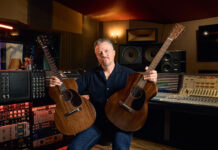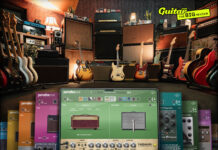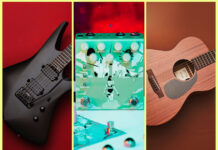
The best guitar amplifiers to buy in 2020: 10 best acoustic amps
If your acoustic has a built-in preamp (as many do these days) and you want to amplify your sound, you can plug direct into a PA or mixer to record, but that’s not the only option. If you’re busking, playing small outdoor gigs, want more control over your tone or simply don’t like the thought of your guitar going into a generic mic preamp that’s not voiced for acoustic guitars, then a standalone amp could be your perfect option.
Modern acoustic guitar amps do a lot more than just make your acoustic sound louder, as well, with various onboard features to expand your tonal options and enhance the overall playing experience. Let’s run down some of the best out there right now.
What to look for when buying an acoustic guitar amplifier
Aside from the different frequency response needs, acoustic guitar amplifiers need a slightly different set of features from an electric guitar amp. Unlike electric amps, tubes aren’t as central to the recipe for acoustics – the vast majority solid-state, and with less need to flap your trousers, you’ll often find smaller speakers. These speakers are usually voiced for a broader frequency range than electric guitar speakers, and are often accompanied by smaller ‘tweeter’ speakers that offer more high-end articulation.
These full-range speaker set-ups serve to not only articulate the nuances of an acoustic guitar’s tone, but also work better if you’re also using it to play a backing track or sing through, something that’s especially important given that acoustic amps are often aimed at solo singer-songwriters. This means that you’ll often find a secondary input channel designed for vocals that comes with its own XLR or XLR combi input, and usually also features its own gain and EQ controls so you can balance guitar and vocals to your taste before they hit the master.
The vasts majority of modern acoustic amps feature a means to plug in your phone or other music playing device, whether that’s via a cable or Bluetooth, and effects are becoming more and more common too. Reverb, chorus and delay are the most common ones you’ll likely find on an acoustic amp, with built-in loopers another increasingly popular feature.
Blackstar Sonnet 60
Blackstar Fly Acoustic
Roland AC60
Fishman Loudbox Mini
Fender Acoustic SFX
Aer Compact 60
THR5A Acoustic
Boss Acoustic Singer Live
Laney A Fresco 60W
Roland CUBE Street
Blackstar Sonnet 60
Image: Blackstar+ Feature-packed, especially given the price
+ Easily giggable
– No phantom power (only on the Sonnet 120)
The Sonnet 60 is a fully-featured acoustic combo designed with virtuoso player John Gomm. Channel one sports a quarter-inch input jack, while channel two has a combo instrument/XLR input – meaning you can use it to amplify both vocals and guitar, or blend between your instrument’s pickup and an external mic. When amplifying a direct signal, the Sonnet’s preamp stages tame the ‘quack’ that’s common to direct acoustic tones, instead reproducing a roomy, natural sound.
There’s a phase reverse switch on channel 1 to prevent feedback, as well as a ground-liftable XLR-out for plugging straight into a mixing board or interface. For backing tracks, the amp sports an eighth-inch line-input on its rear panel. While the 60-watt model doesn’t support phantom power for condenser microphones, the Sonnet 120 does offer this – alongside the addition of an effects loop.
The Sonnet 60 is a strong performer by any standard but the very competitive pricing of Blackstar’s first proper acoustic amp makes it even more attractive.
Price £349 / $399.99 Description Small two-channel acoustic combo with reverb I/O ¼”-in + combo XLR/¼”-in, XLR out, headphone out Power Rating 60W Speakers 1×6.5” + tweeter Effects Channel-independent reverb
Read our full review here.
Blackstar Fly Acoustic Stereo Pack
+ Full sound for the price
+ Easy entry into the world of stereo
– Limited I/O, quiet
Blackstar’s original Fly 3 was a revelation in the world of micro battery-powered amplifiers, doing a remarkable job of warm overdrive and articulate cleans, steering clear of the all-too-common “wasp in a bottle” fizz. The Fly 3 Acoustic brings that tech to the acoustic world, with the Stereo Pack’s accompanying extension cabinet offering even more room-filling 3D sound. The controls are straightforward, with only volume, bass, treble, echo level and echo time to worry about, while a Shape switch changes the character of the EQ.
With just six total watts between the speaker and its cabinet, it’s unlikely that it’ll replace a gigging rig anytime soon – however it’s a very cheap entry point to the world of stereo rigs, and offers a simple solution for anyone wanting a full-sounding small-room setup that won’t break the bank, or take up too much room. The onboard stereo echo can also be a great way of underpinning your unplugged sound with some spacey ambience.
Price $99 / £99 Description Micro-amp combo with matching stereo extension cabinet I/O ¼”-in Speakers 2×3” Effects Echo
Read our full review here.
Roland AC60
Image: Roland+ Automatic anti-feedback
+ In-built effects make good use of stereo operation
– Some more effects options would be good
Speaking of stereo – the Roland Acoustic Chorus AC-60 is another amplifier that lets you tap into that spacey world. Its two channels sport quarter-inch and combo quarter-inch/XLR inputs respectively, with independent volume, bass, treble and midrange controls.
In terms of in-built effects, there are two flavours of chorus, as well as either reverb or delay – all of which make use of the combo’s dual 6.5-inch speakers for stereo width. If you’re planning on cranking it for use in a small venue, Roland’s ‘smart anti-feedback’ is present, meaning you don’t have to worry about gigging an overly resonant guitar. If you’re planning on connecting to a PA, that doesn’t mean sacrificing any stereo width, as the rear panel sports two XLR outputs, as well as a mono line out, and stereo line-ins.
Price £449 / $499.99 Description Two-channel stereo acoustic combo I/O ¼”-in + combo XLR/¼”-in, Stereo XLR-out, ¼”-out Power Rating 2x30W Speakers 2×6.5” Effects Reverb, Chorus, Delay
Fishman Loudbox Mini
+ Portable, especially given its power rating+ Independent reverb levels for vocals and guitar– No effects loop
Fishman electronics are fitted into countless acoustic models, so it’s unsurprising that the brand offers a quality amplifier for acoustics as well. Sporting the familiar arrangement of two channels (one for instrument inputs, one for microphone inputs), the Loudbox balances volume and portability with 60 watts driving a 6.5-inch speaker. Both channels have independent preamp gain, EQ and reverb controls, with the instrument channel sporting a chorus effect and phase switch.
If you’re looking to busk, practice or just fill space Bluetooth connectivity and line-in jacks of both quarter and eighth-inch varieties should cater to all of your backing track needs.
Its main appeal is its portability – while it’s not likely to fill medium-to-large venues on its own, it won’t break your back as you carry it to the gig and offers enough level to be mic’d up, or just be used as an on-stage preamp before running into a desk thanks to the XLR output on the rear of the amp.
Price £259 / $349.95 Description Two-channel mono acoustic combo I/O ¼”-in, XLR-in, XLR-out Power Rating 60W Speakers 6.5” Effects Reverb, chorus (guitar channel), reverb (mic channel)
Fender Acoustic SFX
Fender Acoustic SFX. Image: Fender+ Innovative approach to stereo effects
+ Two channels are identically featured
– Bulkier than some similarly-powered amps
The SFX in this amp’s name isn’t short for stereo effects – nor is it short for special effects. It actually means stereo field expansion, meaning a room-filling side-facing speaker is loaded into the side of the unit, meaning that stereo effects have a much more dramatic width as there’s far more separation between the two signals.
The two channels found in the amp are identical, both sporting separate effects engines and combination XLR/quarter-inch inputs. In between the two control plates, the SFX engine has a large knob to determine the effect’s intensity. Each channel has the option for two flavours of delay, a chorus and a vibrato, as well as a separate control for reverb. This means you can have your guitar soaked in effects while leaving your vocals dry, or the inverse. When it’s engaged, all of the effects make use of the Stereo Field Expansion.
The two channels are rated at 80 watts apiece, so it’s it’s more than loud enough to use for small to medium gigs on its own, or you can run into a mixing board thanks to the XLR out/stereo line-outs on the rear of the amp.
Price £699 / $599.99 Description Two-channel acoustic combo with built-in side-firing Stereo Field Expansion (SFX) speaker I/O 2 x combo XLR/¼”-in, XLR out, stereo line-outs Power Rating 2x80W Speakers 8” front-facing, 6” side-facing Effects SFX-enabled delay, chorus, vibrato and reverb.
Aer Compact 60 Mk4
Image: Aer+ Lots of tone-shaping options for the guitar channel
+ External effects loop
– Expensive
Aer’s take on the two-channel acoustic combo comes with a rugged, reliable design housing some familiar features. Channel one, with a quarter-inch input socket, sports a 3-band EQ, while channel two has a combination XLR/quarter-inch socket and a two-band EQ. Each has a preamp gain control, as well as a clip indicator LED. Channel one also has a ‘colour’ switch, which cuts mids and boosts treble for a little less honkiness.
While there’s a set of two reverbs, a chorus and a delay, the amp also has an external effects loop if you want to throw some stompboxes into the mix – and failing that, the internal effects can be toggled with a footswitch.
In terms of power, the amp drives an 8-inch dual-cone speaker with 60W of solid-state power.
Price £795 / $1,199 Description Two-channel mono acoustic combo I/O ¼”-in + combo XLR/¼”-in, Headphones out, ¼” line out, XLR-out Power Rating 60W Speakers 1 x 8” Effects Reverb, delay, chorus
Yamaha THR5A Acoustic
+ Versatile tones on offer from multiple mic simulations
+ Appealing design, simple operation
– Not powerful enough for some uses
While Yamaha’s regular line of THR amps can handle acoustic signals just fine, the THR5A offers a handy, compact solution for acoustic guitarists who want a ‘serious’ practice amplifier that’s voiced specifically for their instrument.
Using Yamaha’s own modelling techniques, the THR5 emulates the sound of a variety of microphones, lending your direct signal the warmth and responsiveness of a close-mic’d guitar instead. If you’re worried about a loss of clarity, worry not, as you can blend your direct signal with this mic-modelled signal.
In terms of effects, there are two knobs – one for selecting between compression, chorus+compression or just chorus, and another for selecting between delay, reverb+delay or just reverb. As it’s a small desktop amplifier, it’s unlikely that it’ll find a way to replace your gigging rig, but recording the quality mic-emulation is possible with the headphone line-out, and similar to the Blackstar Fly 3 Acoustic it’s capable of complimenting your dry acoustic sound in an intimate gig setting.
Price £175 / $199.99 Description Desktop acoustic amplifier with microphone emulation I/O ¼” in, headphone out Power Rating 5W Speakers 2 x 3” Effects Compression, chorus, reverb, delay
Boss Acoustic Singer Live
Image: Boss+ In-built, Boss-quality effects
+ ‘Acoustic resonance’ to counter piezo quack
– Chorus only for guitar, delay only for vocals
This is Boss’ take on the two-channel acoustic combo, and true to the format it has a dedicated guitar channel and a secondary channel with a combination XLR/quarter-inch jack.
Boss is, of course, well known for its effects. And to that end, the Acoustic Singer Live is loaded with a bunch of them – including a vocal harmoniser, a looper, chorus and reverb, meaning a few of the tools solo performers might use to thicken up a sound are already included.
The guitar channel also has an ‘acoustic resonance’ control, which is Boss’ solution to the potentially unnatural sound of piezo pickups, restoring the natural character of hearing an acoustic in-person or mic’d up. Furthermore, both the vocal and guitar channels sport anti-feedback notch filters. And In terms of volume, there’s 60 watts driving both a 6.5-inch woofer and a dome tweeter.
Price £469 / $499.99 Description Two-channel mono acoustic combo I/O ¼”-in + combo XLR/¼”-in, USB output, Dual XLR outs assignable to outputting individual channels (direct or post-effects) or both channels mixed together Power Rating 60W Speakers 6.5”+tweeter Effects Looper, vocal harmoniser, reverb, chorus
Laney A Fresco 60W
+ Powerful and portable
+ Internal rechargeable batteries saves on AAs
– No tweeter
Laney’s A-Fresco 2 is a modern approach to a portable acoustic amp. Loaded with rechargeable internal lithium-ion batteries, Laney says that the unit can run for up to 24 hours before needing to be recharged.
Its two channels each have independent level, reverb, chorus, bass, midrange and treble controls – alongside a master volume, and an anti-feedback switch. The amp also sports closed-back construction, meaning a mid-focused sound, but if that’s too much honk each channel sports a “shape” button that cuts out some of the midrange.
While the 60 watts of battery-powered amplification makes it a great contender for outdoor gigs or solo busking, If you’re looking to gig in standard venues, then you can still run the amp off mains. A ground-lifted XLR-out also offers an easy way to run straight into a mixing board.
Price £329 / $559.99 Description Battery-powered two-channel mono acoustic combio I/O 2x combo XLR/¼”-in, Power Rating 60W Speakers 1 x 8” Effects Reverb, chorus
Roland CUBE Street
+ It’s ubiquitous for a good reason – it works!
+ Loud volume levels for its size
– Regular use could see you get through a lot of AAs
The best mark of the quality of the Street Cube is that, if you were to take a walk (safely, wear a mask) to your nearest town centre you’ll most likely walk past at least one of them being played in, well, the street. It’s one of the industry standards for portable busking amps and for good reason. Its ruggedised design means it’s happy enough being dragged about wherever, and it runs off a rather convenient set of six AA batteries – still kicking out enough volume for busking and small gigs thanks to its two 6.5-inch speakers.
Like many other amps on this list, it offers two channels, one with a combination XLR/quarter-inch input, and the other for an acoustic (or electric) guitar, or any quarter-inch instrument signal. The instrument side of things offers a more comprehensive set of effects such as chorus, flanger, phaser, tremolo, delay, reverb and a set of amp models, while the microphone/line channel has delay and reverb built-in. The two-channel operation is particularly handy in an amp such as this, meant for outdoor playing or cafe gigs – situations where there might not be another way to amplify your voice.
Price £249 / $299.99 Description Small battery-powered two-channel combo I/O ¼”-in + combo XLR/¼”-in, headphone out Power Rating 5W Speakers 2 x 6.5” Effects chorus, flanger, phaser, tremolo, delay, reverb, amp modelling
The post The best guitar amplifiers to buy in 2020: 10 best acoustic amps appeared first on Guitar.com | All Things Guitar.
Source: www.guitar-bass.net












